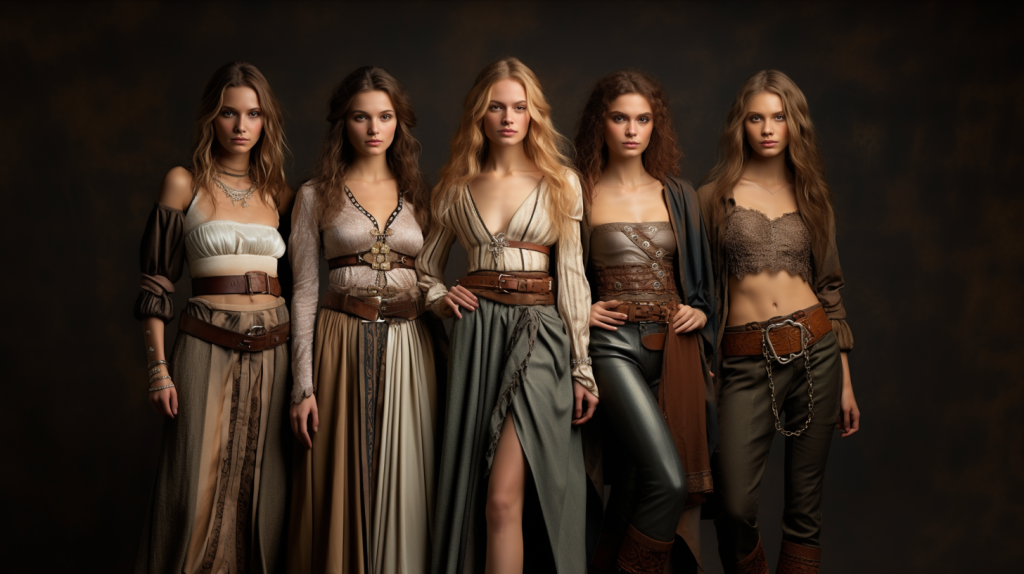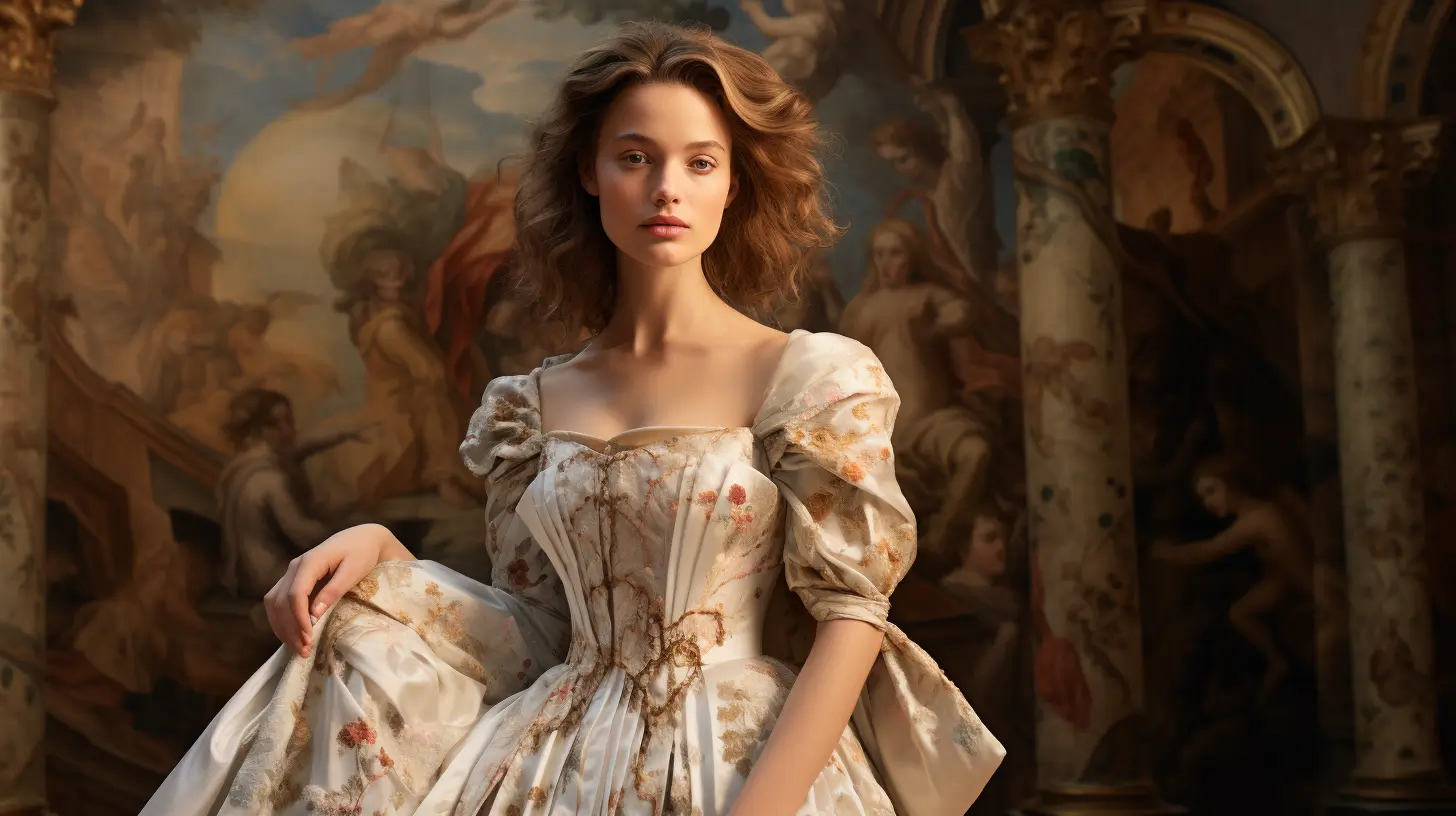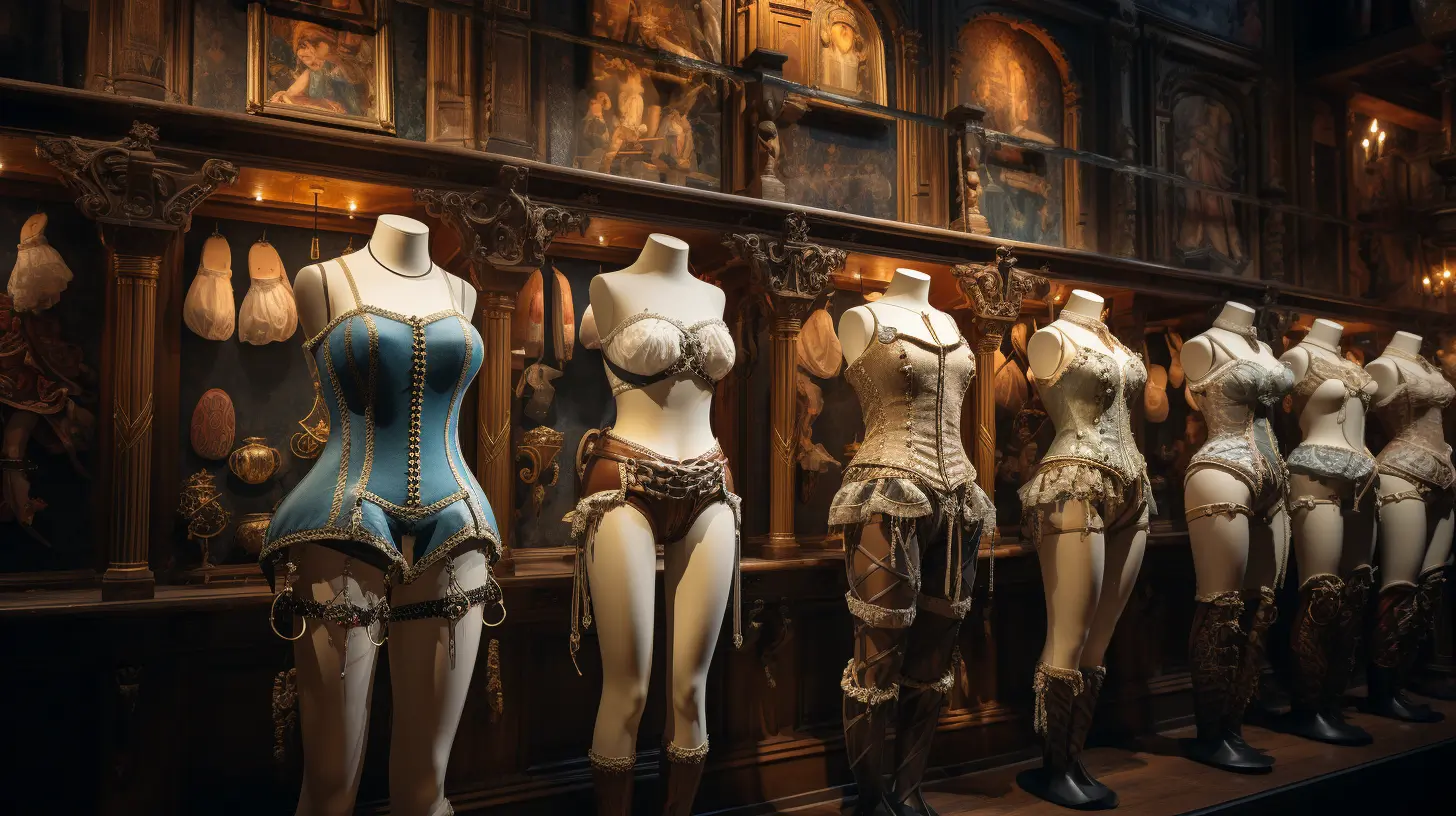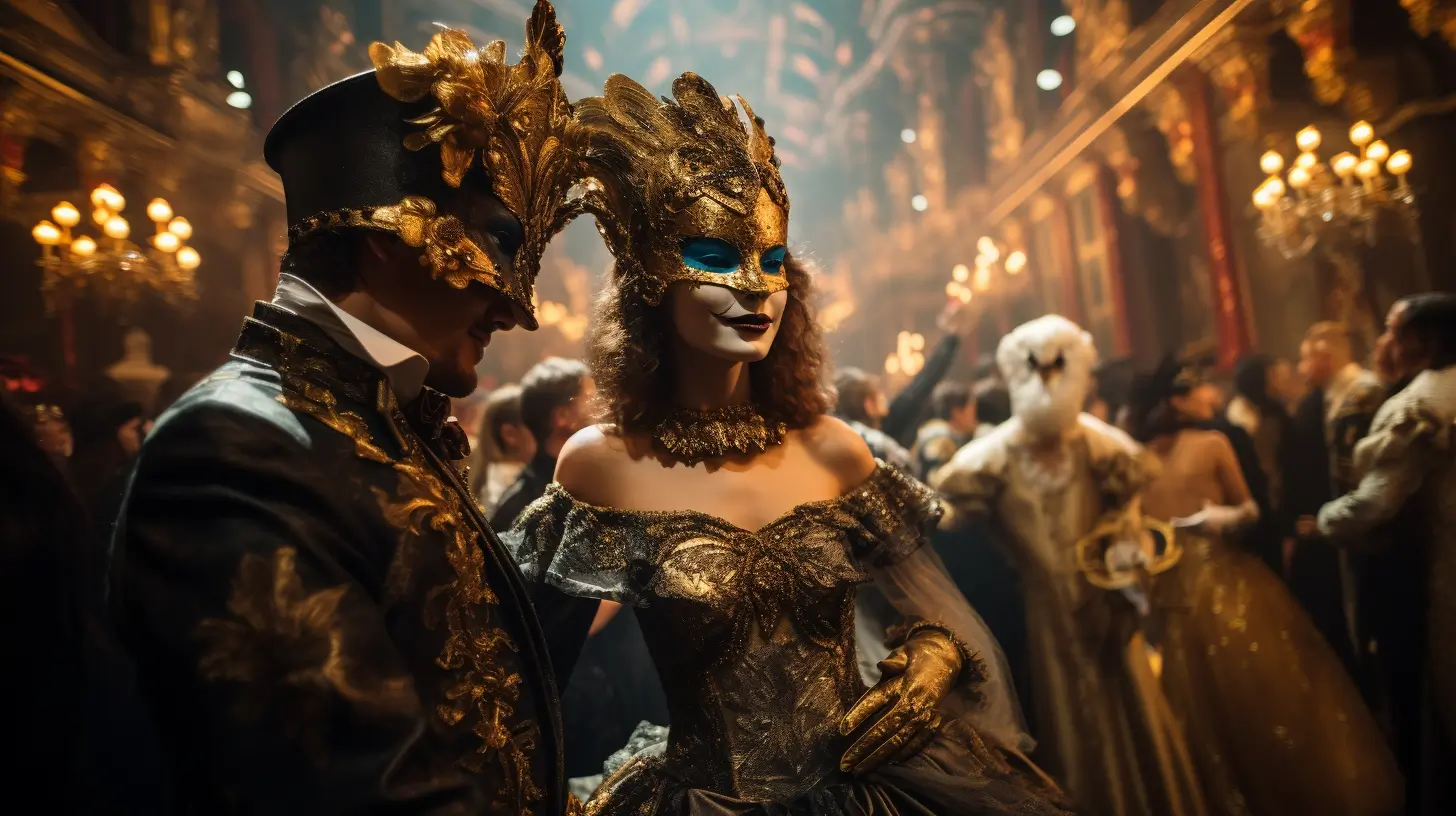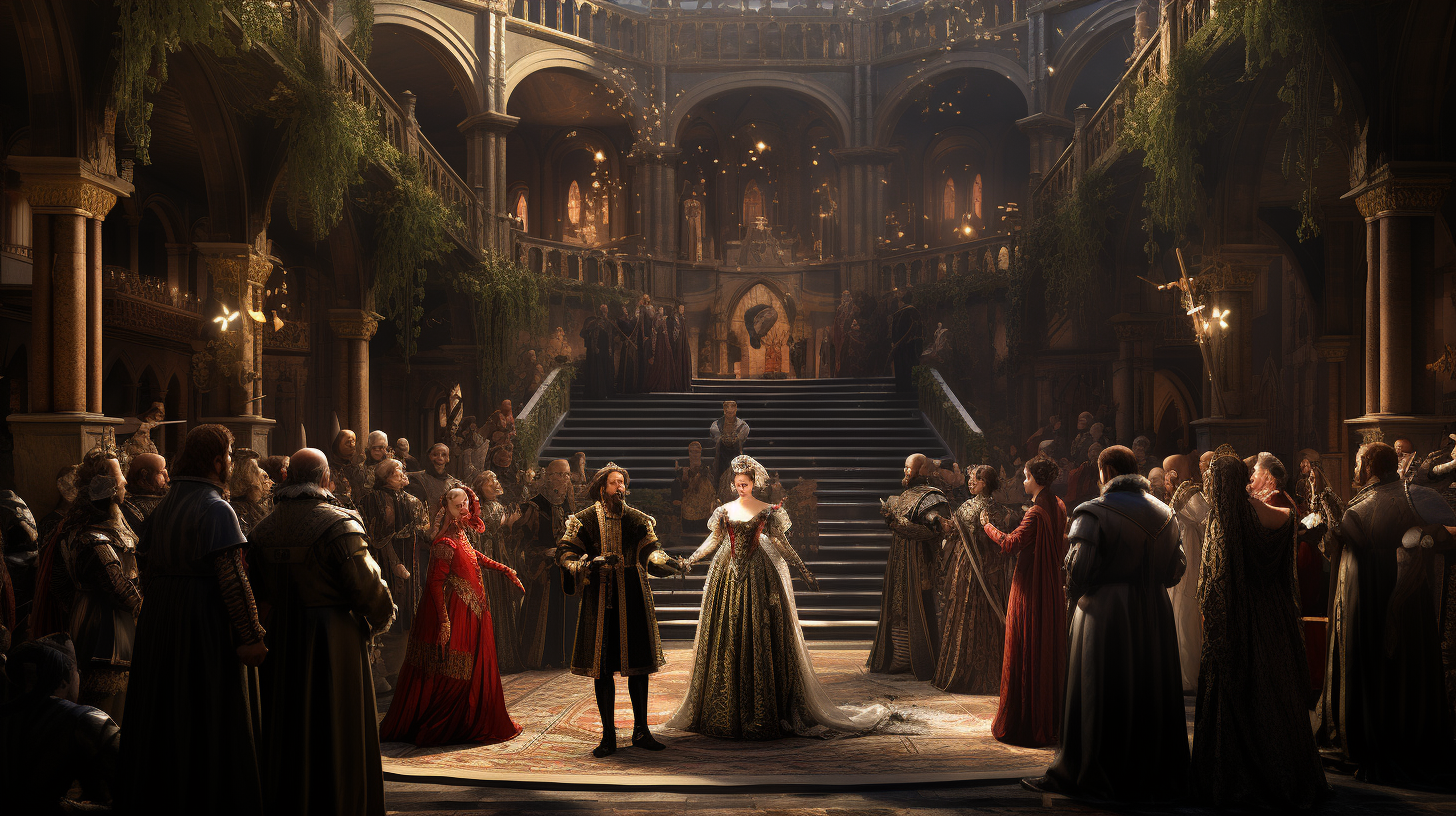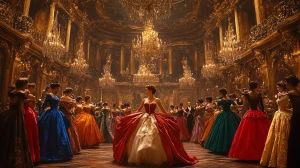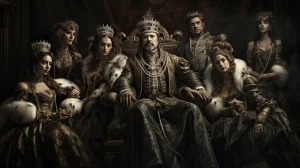
Threads of Time: Unraveling the Mysteries of English Medieval Clothing
Echoes of a Bygone Era
The Allure of Medieval Fashion Imagine stepping back in time, into a world where clothing is not just about covering up, but a vivid storybook of one’s status, profession, and even moral standing. The medieval era, a canvas of vibrant hues and rich textures, is an embodiment of this narrative. Here, every stitch and fold holds a tale, a glimpse into a past both mysterious and intriguing.
Overview of English Medieval Clothing In the heart of England, from the 5th to the 15th century, fashion was a language spoken by all. It wasn’t just fabric; it was a declaration of identity. Nobles draped in silks and velvets, peasants in their hardy wools, each class had its costume. This era saw the transformation from simple tunics to elaborate gowns and doublets, a sartorial journey reflecting the social and cultural metamorphosis of the times.
The Significance of Clothing in Medieval Society In medieval England, your clothes were your banner. They declared your social standing, your wealth, or the lack thereof. Sumptuary laws dictated who could wear what, making clothing a strict code to be adhered to. It was a mirror to the societal hierarchy, a visual representation of the order that governed life.

Early Medieval Fashion (5th-10th Century): When Cultures Collide
The Tangle of Roman Elegance and Anglo-Saxon Grit Imagine a world where the crumbling grandeur of Rome meets the rough-edged pragmatism of the Anglo-Saxons. This era in fashion is not just a chapter from a history book; it’s a saga of two diverging worlds colliding. The Roman influence brought in the flowing tunics and togas, remnants of a once-great empire, while the Anglo-Saxons countered with their robust, earthy garments, designed to withstand the rigors of their toil-filled lives.
Fabrics and Colors: A Palette Carved from Necessity In these times, the art of making clothes was a direct response to the environment. Wool was the fabric of the masses, sheared, spun, and woven by hand. It was a testament to their resilience, their ability to turn the raw, scratchy fleece into something wearable. Colors were not chosen; they were accepted as they came. The dyes were what the earth offered – the yellows of woad, the reds of madder, and the subtle browns and greens from the barks and leaves. This was not a world of vibrancy, but of muted, understated tones that blended with the woods and fields of the English landscape.
Garments: The Everyday Armor Men’s fashion was straightforward – a tunic, typically knee-length, paired with trousers. These were clothes that allowed for movement, for work, for survival. They were the everyday armor of the common man, battered by the elements yet enduring. Women’s clothing echoed this durability. Gowns, often ankle-length, were cinched at the waist, layered over underdresses for warmth. The clothing was functional, yet it had a grace to it, a subtle nod to the fact that even in the toughest times, there is room for dignity, for a sense of self.
The Unspoken Language of Dress Clothing in early medieval England was more than just protection against the cold; it was a language. The length of a tunic, the fit of a gown, each element told a story about who you were, what you did, and where you belonged in the social tapestry of the time. It was a time when fashion was unrefined, unpretentious, and unapologetically real.
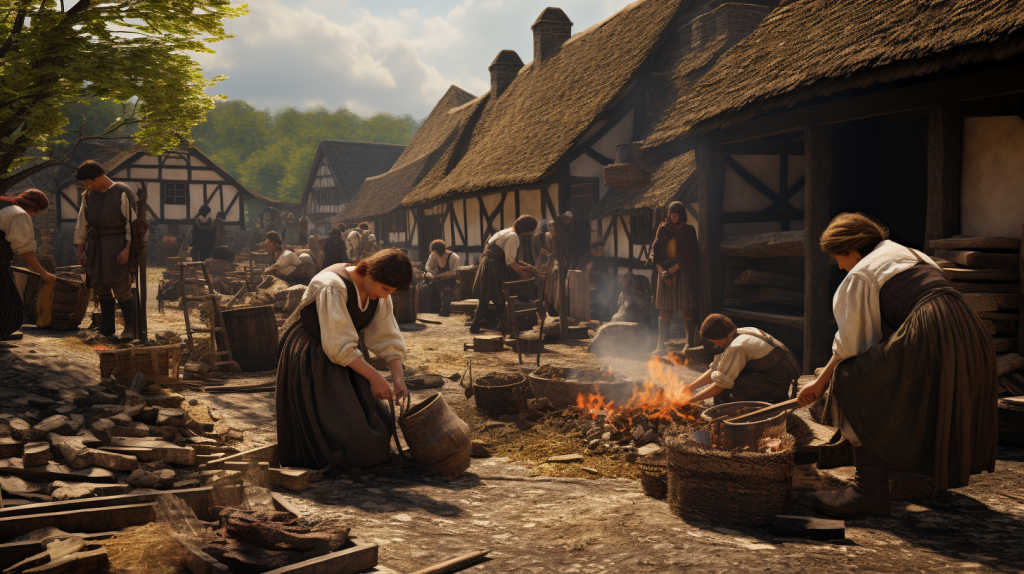
High Medieval Fashion (11th-13th Century): The Dawn of Opulence
The Norman Conquest: A Fashion Revolution
Step into the high medieval period, a time when fashion began to whisper tales of power and prestige. The Norman conquest didn’t just redraw the political map; it rewrote the style guide of England. Norman fashion brought with it a flair for the dramatic – longer, more fitted garments, and an introduction to luxurious fabrics that whispered of the continent’s sophistication. This was the era when clothing began to speak the language of power.
The Evolution of Styles and Silhouettes: A Dance of Decadence
As we journey through the 11th to the 13th centuries, watch the silhouettes of clothing shift and evolve. For men, tunics became longer, more form-fitting, a reflection of a society growing more conscious of appearance and status. Women’s gowns transformed too, embracing the figure, highlighting the waist. Sleeves and hems flirted with extravagance. This was not just clothing; it was architecture – each fold, each seam, a testament to a society growing in complexity and refinement.
Clothing as a Symbol of Rank and Prestige
In the high medieval age, your attire was your badge of honor. The rich adorned themselves in velvets and silks, fabrics that screamed of wealth and power. Furs lined the cloaks of the nobility, a subtle yet unmistakable display of status. This was an era where what you wore could speak volumes about who you were, or who you aspired to be. Clothing was not just about style; it was about making a statement, loud and clear.
The Unfolding Drama of High Medieval Fashion
As these years unfolded, so did the drama in fashion. The courtly circles saw an infusion of color, texture, and form. Embroidery began to creep into garments, adding yet another layer of opulence. This period was a turning point, a pivot from the purely practical to the proudly ostentatious. It was a time when fashion began to dream, to aspire, to reach for something beyond mere necessity.
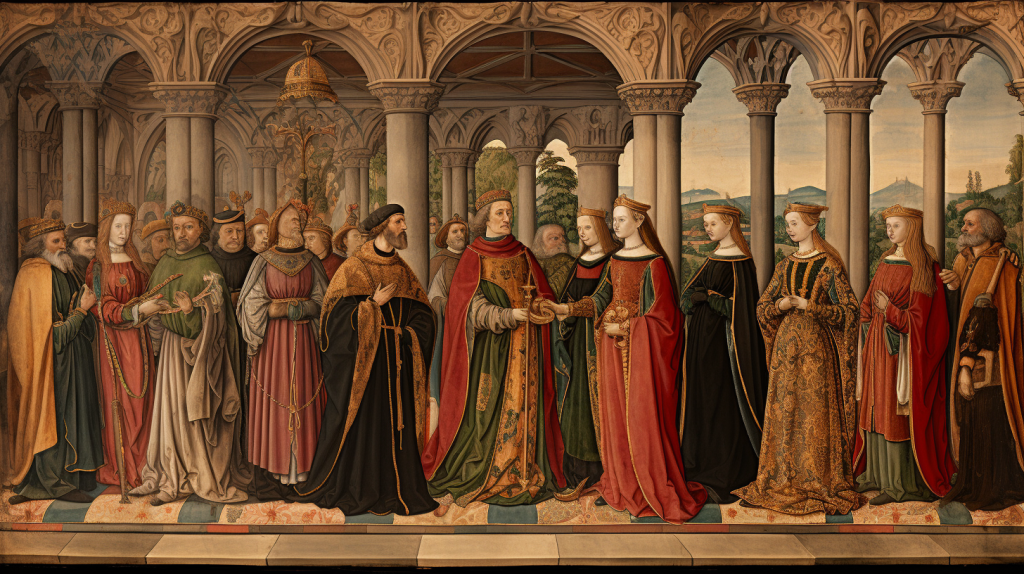
Late Medieval Fashion (14th-15th Century): The Age of Elegance and Excess
The Gothic Influence: A Dance with Drama As we stride into the late medieval period, we’re stepping into an age where fashion takes a dramatic turn. The Gothic influence is like a dark, brooding character in this narrative, bringing with it pointed arches and soaring lines not just in architecture but in clothing as well. It’s a world where the aesthetic is tinged with a kind of elegant gloom, a stark contrast to the earlier simplicity.
The Tailoring Revolution: Sculpting the Human Form This era marks the rise of true tailoring. Clothes are no longer just draped; they are engineered. For men, the once-loose tunics are now body-hugging jackets, the hosen (early form of trousers) sculpted to the leg. Women’s gowns embrace the body, with lacing and buttons adding both form and function. This is the time when clothing starts to articulate the human figure with a precision that’s almost scientific, a celebration of the human form in fabric and thread.
Extravagance in Noble Attire: A Display of Splendor In the courts of the nobility, fashion becomes a playground for the extravagant. Picture the scene: velvet and silk gowns with fur-lined sleeves, voluminous and bedecked with jewels and embroidery. For the nobles, these garments are more than just attire – they’re a statement, a manifestation of wealth and power. It’s here, in these ostentatious halls, that fashion becomes a language of opulence, a loud and unabashed proclamation of status.
The Late Medieval Silhouette: A Bold Stroke on the Canvas of History This era in fashion is bold, unapologetic, and flamboyant. It’s a vivid stroke on the canvas of history, a blend of artistic expression and social statement. From the dramatic Gothic lines to the meticulous tailoring, every seam, every fold in the fabric tells a story of a society in transition, a world teetering on the edge of the modern era.
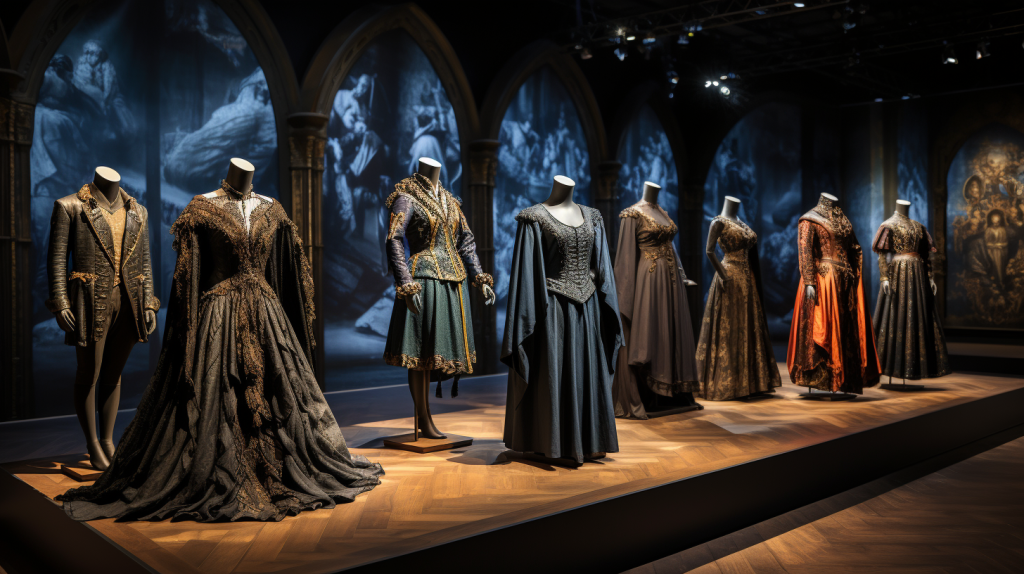
Materials and Fabrics: The Building Blocks of Medieval Style
Wool, Linen, and Silk: The Trifecta of Medieval Fabric Step into the world of medieval textiles, where the story is as much about the cloth as it is about the clothes. Wool, linen, and silk – these aren’t just materials; they’re the characters in our story. Wool, the stalwart companion of the commoner, rugged and reliable. Linen, the understated hero, cool and comfortable, a staple in a world without synthetics. And silk – oh, silk – the seductive luxury, a whisper of wealth and exotic lands, reserved for those who could afford its whispers.
The Alchemy of Dyeing and Coloring Dyeing in the medieval era was no less than alchemy. It was a world where color was conjured from nature – plants, minerals, and even insects. This wasn’t just about dipping fabric in a vat of color; it was a complex dance of chemistry, timing, and skill. The deep blues from woad, the rich reds from madder – each color a testament to the dyer’s art. And let’s not forget the ultimate status symbol – the Tyrian purple, a hue so exclusive, so expensive, it was reserved for royalty.
The Import of Luxury Fabrics: A Tale of Trade and Intrigue Imagine the medieval marketplace, a buzzing hub of trade where luxury fabrics were as prized as jewels. Silk was not just a fabric; it was a commodity that traversed the Silk Road, a symbol of connection between distant worlds. The import of these fabrics was a story of adventure, of caravans braving deserts and seas to bring these treasures to European shores. These materials were more than just textiles; they were threads that wove together cultures and continents.
The Fabric of Medieval Life In medieval fashion, the fabric told the story of the wearer – where they came from, what they did, and how they fit into the tapestry of society. From the shepherd in his woolen tunic to the lady in her silk gown, each fabric was a choice, a statement, a piece of a larger narrative.
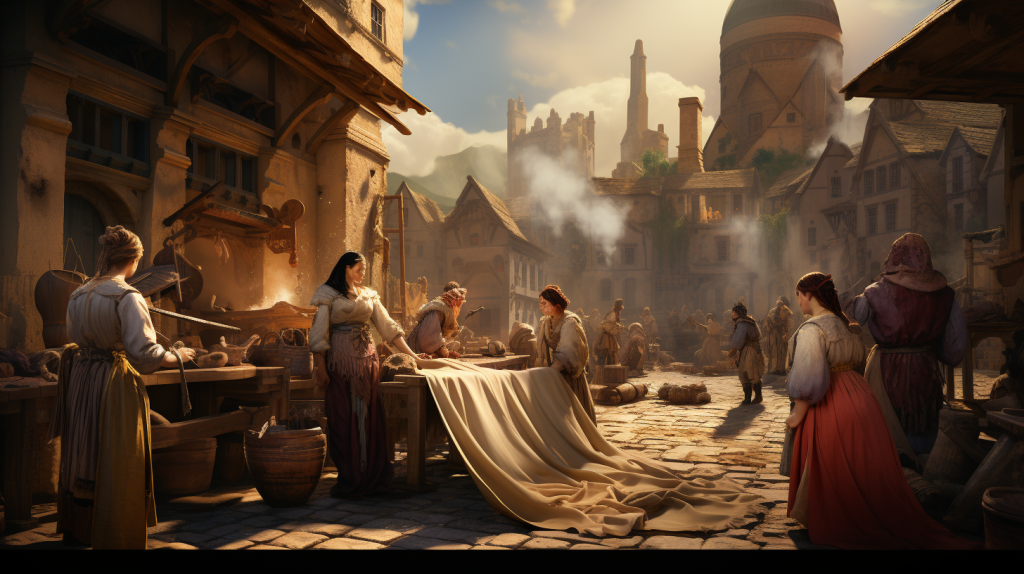
Garments and Attire: The Armor of Everyday Life
Outerwear: The Majesty of Cloaks and Surcoats In the medieval wardrobe, outerwear wasn’t just about battling the cold; it was about making a statement. Cloaks and surcoats were the banners under which individuals paraded their status and style. The cloak, flowing and majestic, could turn a simple outfit into a statement of elegance. The surcoat, meanwhile, was the medieval version of the billboard – often adorned with family crests or heraldic symbols, it was a wearable piece of personal history.
Undergarments: The Unsung Heroes Beneath the layers of pomp and pageantry lay the humble undergarments: shirts for men and chemises for women. These weren’t items meant for public display, but they were the foundation upon which medieval fashion was built. Made from linen, they were the barrier between skin and the sometimes harsh outer fabrics. These undergarments tell a story of practicality, a necessary concession to comfort in an age where comfort was often a luxury.
Headwear: Crowns, Hoods, and Headdresses The headwear of the medieval era was as varied as it was symbolic. From the utilitarian hoods of the working class to the elaborate headdresses of the nobility, what you wore on your head was a clear indicator of who you were. Crowns were the ultimate symbol of power, intricate and heavy with the weight of authority. Headdresses, often elaborate and decorative, were a canvas for expression among the upper classes, a playground for fashion’s more artistic impulses.
The Tapestry of Medieval Attire In medieval fashion, every garment had its role, its purpose. From the practical undergarments to the symbolic headwear, each piece played a part in the grand performance of social and personal identity. This was a world where what you wore was a reflection of your place in the grand scheme, a visual story of status, profession, and culture.
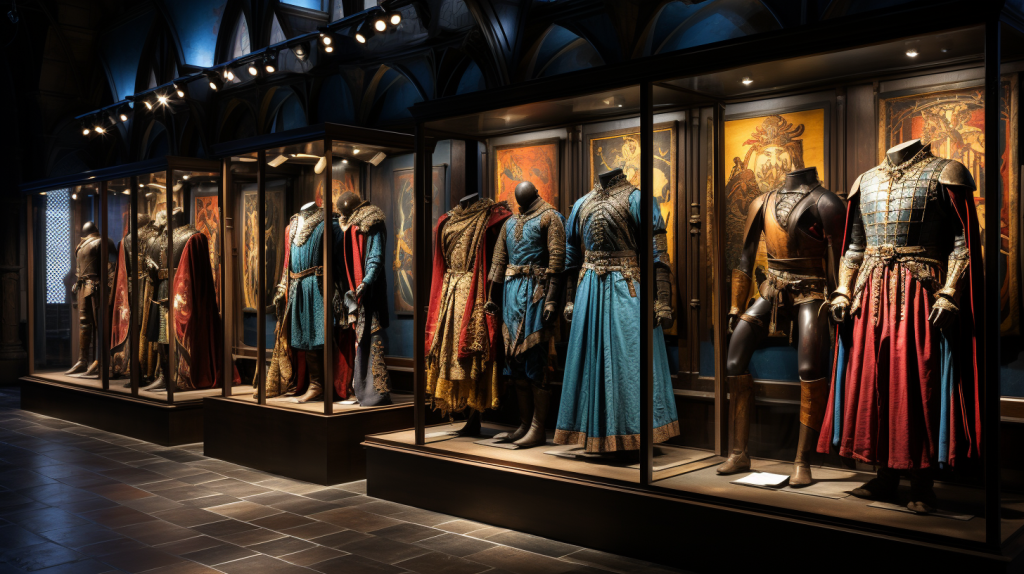
Fashion for the Nobility: A Dance of Decadence and Power
Lavishness and Luxury: The Rich Tapestry of Noble Attire In the realm of medieval nobility, fashion was more than just clothing – it was a performance, a dazzling show of wealth and status. The nobles didn’t just wear clothes; they adorned themselves in garments that spoke of opulence and extravagance. Fabrics were rich and heavy, dripping with luxury. Velvets, satins, and furs weren’t just choices; they were declarations. Each stitch, each embroidered motif, was a display of not just personal taste, but of power, influence, and wealth.
Sumptuary Laws: The Fashion Police of the Middle Ages In this world of extravagance, sumptuary laws were the rulebook. These weren’t just guidelines; they were strict regulations dictating who could wear what. Imagine laws so precise they could dictate the type and amount of cloth, the kinds of fur, even the colors you were allowed to wear. These laws were a tangible expression of the social hierarchy, a way to keep the lavishness of the nobility in check and ensure the visual distinction between the classes remained crystal clear.
Jewelry and Accessories: The Accents of Aristocracy In medieval noble fashion, accessories were the exclamation points in a statement of elegance. Jewelry was not just adornment; it was a symbol of status and wealth. Gold, silver, precious stones – these were the currencies of vanity. Brooches, rings, necklaces, each piece a glittering signifier of rank. Accessories like belts and purses were not just functional; they were ornamental, often studded with jewels and intricate designs. In the world of medieval nobility, every accessory was an opportunity to showcase wealth and status.
Fashion as a Reflection of Feudal Hierarchy For the medieval nobility, fashion was a mirror reflecting the feudal system. It was a visual representation of the social order, a sartorial map of the hierarchy. This was a world where your clothes could quite literally define you, where the fabric of your garment could tell your story long before you uttered a single word.
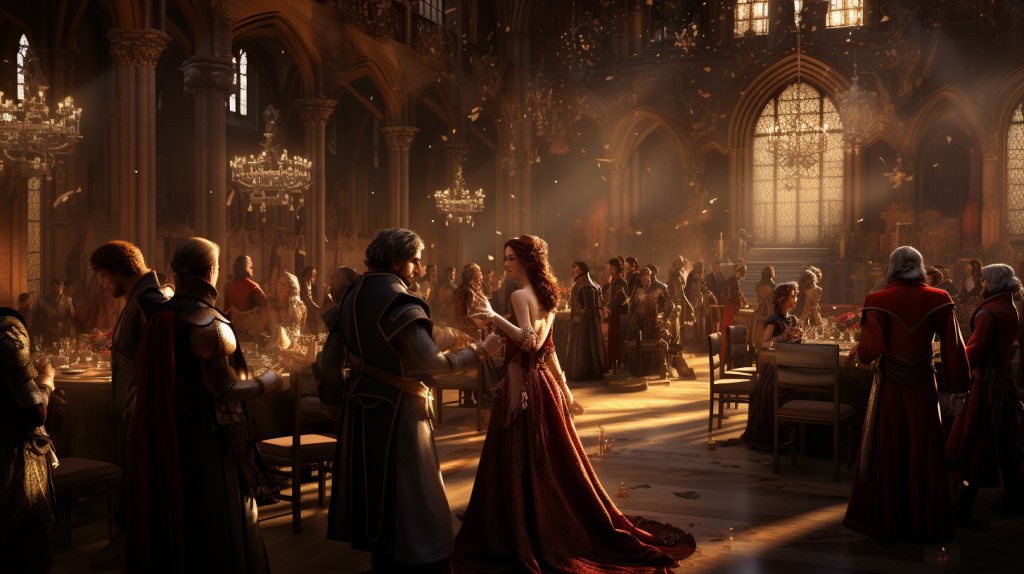
Peasant and Commoner Clothing: A Tale of Resilience and Resourcefulness
Practicality and Simplicity: The Core of Commoner Fashion In stark contrast to the nobility’s flamboyance, the clothing of peasants and commoners was a testament to practicality and simplicity. This was fashion stripped down to its bare essentials, born out of necessity and function. Garments were robust, designed to withstand the rigors of hard labor and the whims of the elements. This wasn’t about making a statement; it was about making it through the day.
Homemade and Hand-Me-Down Garments: The Fabric of Life In the world of the common folk, clothing was a self-made affair. Every stitch told a story of a garment lovingly crafted at home, often handed down through generations. These pieces weren’t just clothes; they were narratives woven into fabric, tales of survival, and family heritage. In a time when nothing was wasted, patches and repairs added character to these garments, each one a unique patchwork of history.
Seasonal Adaptations: Clothing in Tune with Nature For the medieval commoner, adapting to the seasons was a matter of survival. Their wardrobe was a reflection of this – heavy cloaks for the biting cold of winter, lighter tunics for the toil under the summer sun. This was clothing in harmony with nature, an unspoken understanding of the rhythm of the seasons. It was a cycle of life mirrored in the fabric they wore, a dance of adaptation and resilience.
The Unsung Heroes of Medieval Fashion While the nobility basked in the luxury of their silks and velvets, the commoners held the true essence of medieval fashion – clothing that told the real story of the era. It was an unvarnished tale of endurance, of making do with what you had, of clothing that wasn’t just worn but lived in.

Children’s Clothing in Medieval England: Small Clothes, Big Stories
Miniature Mirrors of Adult Fashion In medieval England, children’s clothing wasn’t a separate universe of playful designs and bright colors. No, it was a direct reflection, a miniature version of adult attire. Little lords and ladies were decked out in scaled-down versions of gowns and doublets, tiny tunics, and breeches. This was more than a fashion choice; it was a social statement, embedding children into the fabric of the societal structure from a young age.
Dressing Up the Ages: Garments for Every Stage From swaddling bands for infants to more elaborate dresses and tunics for older children, clothing was an integral part of growing up in medieval times. Each stage of childhood had its corresponding attire, marking the transition from one phase of life to the next. It was a visual journey of growth, with each garment representing a new chapter in a young life.
Clothes and Childhood Development: A Subtle Dance In medieval society, clothing played a subtle yet significant role in childhood development. Dressing a child as a small adult wasn’t just about aesthetics; it was about preparation, about teaching them their place and role in the complex tapestry of feudal life. Clothes were a child’s first lesson in social identity, a primer in the unspoken language of class and status.
The Littlest Bearers of Fashion’s Legacy In the realm of medieval fashion, children were more than just passive recipients of clothing; they were active participants in the grand narrative of style. Through their miniature garments, they carried the legacy of their family’s social standing, becoming a living, breathing extension of their lineage and heritage.
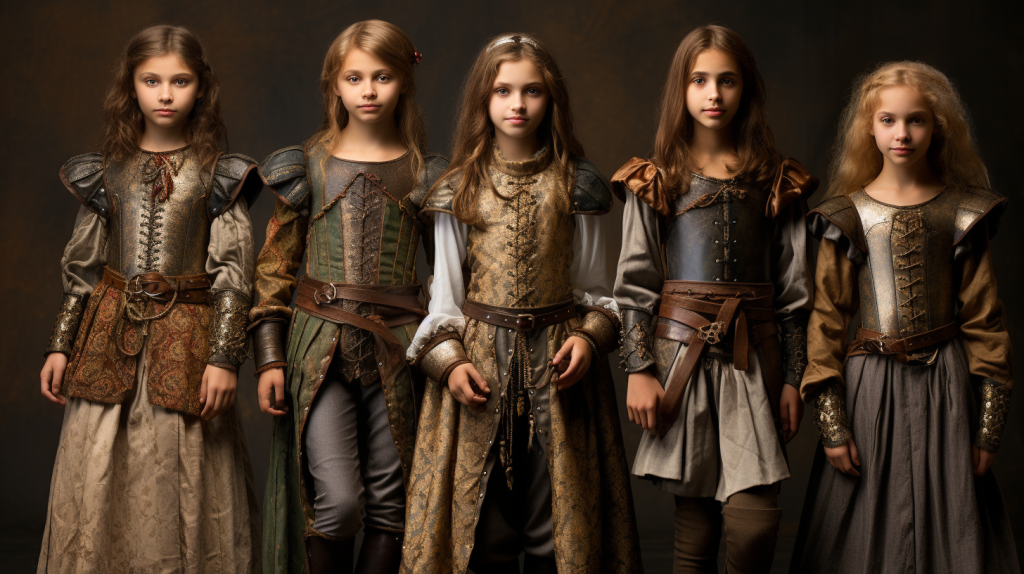
Special Occasions and Ceremonial Attire: The Fabric of Life’s Milestones
Wedding Garments: Tying the Knot in Style In medieval England, a wedding wasn’t just a union of hearts; it was a spectacle of fashion. Wedding garments were a canvas to display wealth, status, and family pride. Brides would often wear their most lavish gowns, not necessarily white, but bursting with colors, embroidered with gold and silver threads. Grooms, not to be outdone, donned their finest tunics and cloaks, often embellished with intricate designs. This was the medieval way of celebrating love – loud, proud, and in full regalia.
Mourning and Funeral Attire: The Somber Silhouettes Contrasting the vibrancy of weddings, mourning and funeral attire in medieval times was steeped in solemnity. This was fashion serving a ritual – dark, understated, yet dignified. Mourning clothes were more than just garments; they were a public display of grief and respect. The fabrics were muted, often in shades of black, grey, or deep blues and purples, embodying the gravity of loss and remembrance.
Festive and Ceremonial Clothing: Celebrating in Grandeur Festive occasions in medieval England were an opportunity for society to shed its everyday skin and don something more fantastical. This was where the true flair of medieval fashion came to life – bright colors, luxurious fabrics, and ornate accessories. Whether it was a royal banquet, a religious procession, or a public festival, ceremonial clothing was about celebrating life and its many spectacles. Every stitch, every hue, sang songs of joy, community, and shared human experience.
The Threads That Wove Together Life’s Tapestry In medieval times, special occasions were interwoven with the ceremonial attire that graced them. These garments were more than just clothes; they were an integral part of the celebration, markers of life’s milestones, and carriers of tradition and culture.
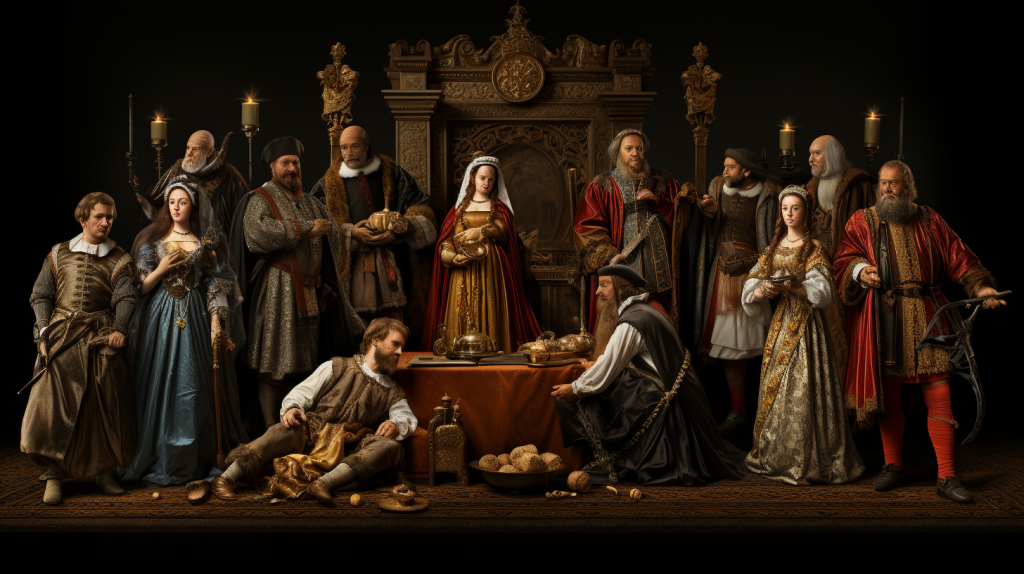
The Legacy of English Medieval Clothing: Echoes Through Time
Influence on Modern Fashion: The Timeless Echo The whispers of medieval fashion still resonate in today’s fashion world, like an old song that never fades. The influence is subtle yet unmistakable – a line here, a cut there, a nod to the elaborate. Modern haute couture often tips its hat to the dramatic silhouettes and rich textures of the medieval era. From the runways of Paris to the streets of New York, echoes of medieval style peep through, proving that good design is indeed timeless.
Preservation and Study in Museums: Fashion Frozen in Time In the quiet halls of museums, the legacy of medieval clothing is preserved like precious relics. Here, behind glass, the garments tell their centuries-old stories – of feasts and famines, wars and weddings. To study these pieces is to unravel the threads of history, to understand not just the how of fashion, but the why. These museums don’t just preserve clothing; they preserve the essence of an era long gone but never forgotten.
The Enduring Appeal of Medieval Styles: A Lasting Fascination There’s something about medieval fashion that continues to captivate us. Maybe it’s the romance of it, the chivalry, the hint of a world that was simpler, yet more ornate. The appeal endures in various forms – in movies, television shows, and even in the way we romanticize events like Renaissance fairs. It’s a style that refuses to be relegated to the dusty shelves of history, insisting on its place in the tapestry of modern culture.
Medieval Fashion: Not Just History, But a Story The legacy of English medieval clothing is more than just a chapter in the history of fashion; it’s a continuous narrative, a conversation between the past and the present. It reminds us that fashion is not just about trends; it’s about storytelling, about the human urge to express and to adorn.
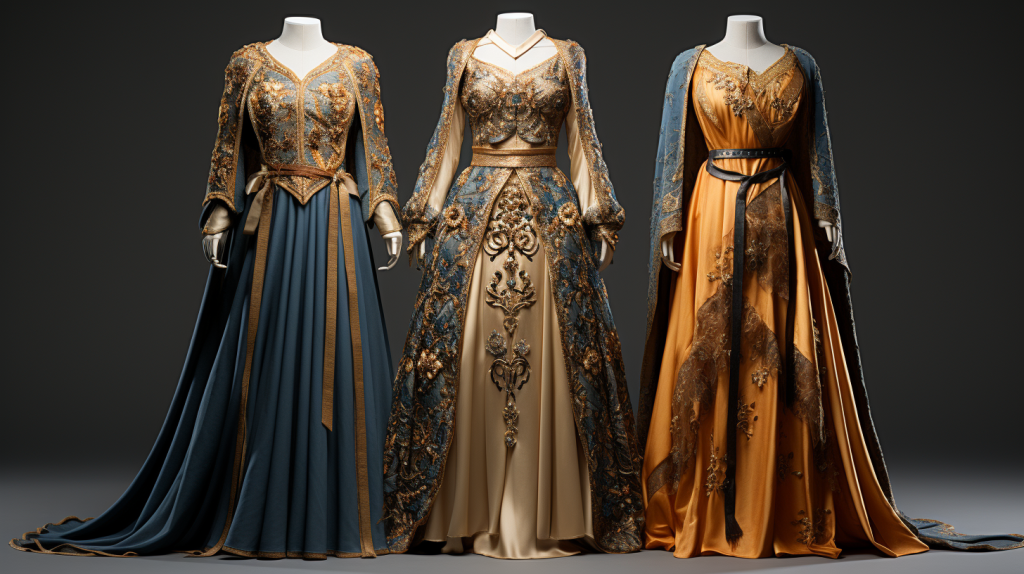
The Timeless Journey of Medieval Fashion
Reflecting on the Tapestry of Medieval Fashion As we come to the end of this journey through medieval fashion, it’s like stepping back from a richly woven tapestry. The vivid threads of history, culture, and artistry entwine to tell a story that’s about more than just clothing. It’s a narrative of human expression, societal structures, and the eternal dance between necessity and extravagance. This journey has been a deep dive into a world both alien and strangely familiar, where each garment tells a story, each fabric holds a secret.
The Lasting Echo of Medieval Style in the Modern World The impact of English medieval clothing on modern style is like a subtle undercurrent in the vast ocean of fashion. It’s there in the fall of a sleeve, the cut of a gown, the resurgence of corsetry, and the undying love for dramatic, sweeping cloaks. These ancient styles continue to inspire designers, artists, and fashion enthusiasts, reminding us that the past is never really past. Medieval fashion, with its richness and complexity, continues to fascinate, influence, and inspire.
An Invitation to Continue the Exploration As we wrap up this exploration, the conversation is far from over. Fashion, like history, is a living, breathing entity, constantly evolving and growing. I invite you, the reader, to continue this exploration. Share your thoughts, your insights, and your questions. What aspect of medieval fashion captivates you the most? How do you see its influence in today’s fashion world? This is not just a story to be read; it’s a story to be discussed, debated, and delved into.
The Unending Journey of Fashion Through Time In closing, our journey through the realms of medieval fashion is a reminder that fashion is a journey, not a destination. It’s a continuous thread that connects us to our past, weaving through the present and stretching into the future. It’s a journey that each of us is a part of, in the clothes we wear, the styles we choose, and the stories we tell through them.
